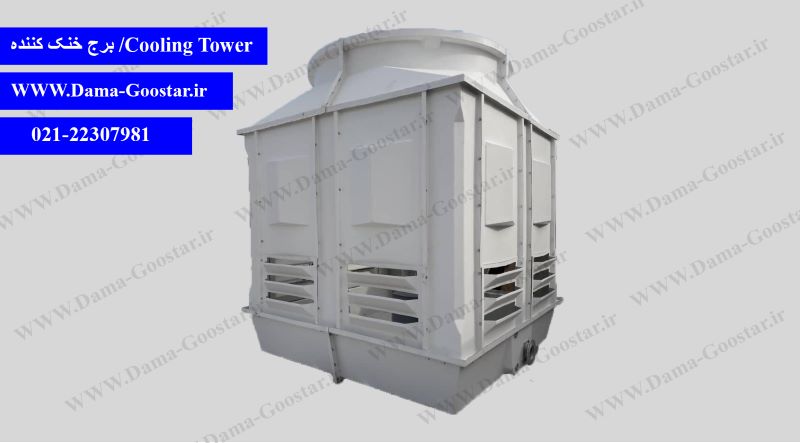Cooling Tower (Cooling Tower) in general, the term cooling tower has had many applications in the global industry and throughout history. The first works of design of cooling towers or cooling towers can be seen in ancient Egypt in order to cool the water used for bathing and by spraying the free flow of water stream on the man-made rocks. After many years, humans used this device in many cases without knowing the technical knowledge and design of the cooling tower and even without knowing the name and design knowledge of the cooling tower.
After the European Industrial Revolution and the growth of industry in the world, the direct use of water from rivers, streams, lakes and wells to cool industrial devices expanded. For years, the method of direct use of natural resource water to cool industrial equipment was the first choice of large industrial plants. After several decades and the increasing reduction of natural resources, many factories due to lack of water resources or environmental effects of excessive water consumption and also increasing pollution of water resources to find a suitable solution to return water consumption from natural resources and combat The above problems (cooling tower), acted.
The first cooling tower, called Cooling Water Builder, was placed in the way of river water, and in this work cycle, in order to return the hot water used by rivers in industrial factories, it was put into orbit. Early cooling towers often had very large concrete structures. Concrete cooling towers have been used since the European Industrial Revolution. Today, cooling towers with concrete structures are generally used in hyperbolic and cubic shapes in the power plant and petrochemical industries in the country. This model of cooling tower is also called power plant cooling tower.
The next generation of cooling towers over time is the wooden cooling tower. The wooden cooling tower was generally considered a suitable alternative to the concrete cooling tower in smaller scales due to its faster construction and lower weight. In the wooden cooling tower, the first type of cooling tower packing with wooden structure was used.
After a while, the wooden cooling tower was completely removed from the industrial application circuit due to insufficient resistance to rot and sunburn, as well as due to water absorption and deformation over time in its structure, and galvanized cooling tower or Galvanized cooling tower with centrifugal aeration system replaced wooden cooling tower.
Galvanized cooling tower was a good alternative to wooden cooling tower due to its higher resistance to decay, no deformation and more stable structure. Eventually, the galvanized cooling towers were also reactive to water, and the effects of rust, rot, and the growth of microorganisms (sludge) were quickly seen. Galvanized cooling tower repairs, or so-called metal cooling towers, were extremely difficult due to rusting connections and lack of easy access to the internal components of the cooling tower.
For the above reasons, the latest generation of cooling towers, called fiberglass cooling towers, have completely replaced concrete, wood and galvanized cooling towers. Fiberglass cooling tower A type of cooling tower with a composite or fiberglass structure has numerous advantages over its previous models, which we will mention briefly.
1- Lightness and portability of fiberglass cooling tower
2. Easy maintenance of fiberglass cooling towers compared to various types of galvanized cooling towers and concrete cooling towers
3. No penetration of sunlight (lack of absorption of solar radiation due to the apparent white color of the body) into the fiberglass cooling tower
4- No reaction with water or in other words no rot and rust of the fiberglass body of the cooling tower against water
5. Lack of growth of bacteria, microorganisms and sludge in the pan of fiberglass cooling tower
Fiberglass Cooling Tower is an all-composite body made of suitable fibers and resins. Fiberglass cooling tower is produced and designed today in various types of open circuit cooling towers and closed circuit cooling towers. The new generation of cooling towers with the aim of reducing the compensatory water consumption of the cooling tower, reducing the amount of sediment in the cooling tower and in general with the aim of optimizing the energy consumption of the cooling tower, called hybrid cooling tower and evaporative cooling tower or evaporative condensers. evaporative condenser) has replaced a variety of open circuit cooling towers.
In a general statement, it can be said that all industrial and non-industrial equipments used by human beings have undergone many changes over time, and the cooling tower, like many other industrial equipments, has undergone many changes and transformations. Cooling tower On the one hand, in terms of the quality of materials used in the production of this device, and on the other hand, in the overall design of the cooling tower, general changes can be seen.
In order to improve the quality of its products as much as possible, especially the cooling tower, Damagostar Company intends to take steps with the latest technical knowledge of the world and by using the unremitting efforts of its engineers. The cooling tower of Damagester company is produced in different types and in different application directions in accordance with the up-to-date knowledge of the world and is in the service of the country's industry.

